#Copenhagen Interpretation
Text

What Does Quantum Physics Imply About Consciousness?
In recent years much has been written about whether quantum mechanics (QM) does or does not imply that consciousness is fundamental to the cosmos. This is a problem that physicists have hotly debated since the earliest days of QM a century ago. It is extremely controversial; highly educated and famous physicists can't even agree on how to define the problem.
I have a degree in physics and did some graduate level work in QM before switching to computer science; my Ph.D. addressed topics in cognitive science. So I'm going to give it a go to present an accessible and non-mathematical summary of the problem, hewing to as neutral a POV as I can manage. Due to the complexity of this subject I'm going to present it in three parts, with this being Part 1.
What is Quantum Mechanics?
First, a little background on QM. In science there are different types of theories. Some explain how phenomena work without predicting outcomes (e.g., Darwin's Theory of Evolution). Some predict outcomes without explaining how they work (e.g., Newton's Law of Gravity.)
QM is a purely predictive theory. It uses something called the wave function to predict the behavior of elementary particles such as electrons, photons, and so forth. The wave function expresses the probabilities of various outcomes, such as the likelihood that a photon will be recorded by a detection instrument. Before the physicist takes a measurement the wave function expresses what could happen; once the measurement is taken, it's no longer a question of probabilities because the event has happened (or not). The instrument recorded it. In QM this is called wave function collapse.
The Measurement Problem
When a wave function collapses, what does that mean in real terms? What does it imply about our familiar macroscopic world, and why do people keep saying it holds important implications for consciousness?
In QM this is called the Measurement Problem, first introduced in 1927 by physicist Werner Heisenberg as part of his famous Uncertainty Principle, and further developed by mathematician John Von Neumann in 1932. Heisenberg didn't attempt to explain what wave function collapse means in real terms; since QM is purely predictive, we're still not entirely sure what implications it may hold for the world we are familiar with. But one thing is certain: the predictions that QM makes are astonishingly accurate.
We just don't understand why they are so accurate. QM is undoubtedly telling us "something extremely important" about the structure of reality, we just don't know what that "something" is.
Interpretations of QM
But that hasn't stopped physicists from trying. There have been numerous attempts to interpret what implications QM might hold for the cosmos, or whether the wave function collapses at all. Some of these involve consciousness in some way; others do not.
Wave function collapse is required in these interpretations of QM:
The Copenhagen Interpretation (most commonly taught in physics programs)
Collective Collapse interpretations
The Transactional Interpretation
The Von Neumann-Wigner Interpretation
It is not required in these interpretations:
The Consistent Histories interpretation
The Bohm Interpretation
The Many Worlds Interpretation
Quantum Superdeterminism
The Ensemble Interpretation
The Relational Interpretation
This is not meant to be an exhaustive list, there are a boatload of other interpretations (e.g. Quantum Bayesianism). None of them should be taken as definitive since most of them are not falsifiable except via internal contradiction.
Big names in physics have lined up behind several of these (Steven Hawking was an advocate of the Many Worlds Interpretation, for instance) but that shouldn't be taken as anything more than a matter of personal philosophical preference. Ditto with statements of the form "most physicists agree with interpretation X" which has the same truth status as "most physicists prefer the color blue." These interpretations are philosophical in nature, and the debates will never end. As physicist M. David Mermin once observed: "New interpretations appear every year. None ever disappear."
What About Consciousness?
I began this post by noting that QM has become a major battlefield for discussions of the nature of consciousness (I'll have more to say about this in Part 2.) But linkages between QM and consciousness are certainly not new. In fact they have been raging since the wave function was introduced. Erwin Schrodinger said -
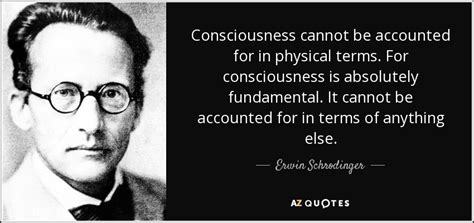
And Werner Heisenberg said -

In Part 2 I will look deeper at the connections between QM and consciousness with a review of philosopher Thomas Nagel's 2012 book Mind and Cosmos. In Part 3 I will take a look at how recent research into Near-Death Experiences and Terminal Lucidity hold unexpected implications for understanding consciousness.
(Image source: @linusquotes)
#quantum physics#consciousness#copenhagen interpretation#superdeterminism#many worlds#philosophy#physics#philosophy of mind#brain#consciousness series
95 notes
·
View notes
Text
"The presence of an observer in an experiment alters the outcome of the experiment itself."

Born Werner Karl Heisenberg
5 December 1901 Würzburg, Kingdom of Bavaria, German Empire
Died 1 February 1976 (aged 74) Munich, Bavaria, West Germany
He formulated the Uncertainty Principle: One of Heisenberg's most significant contributions to physics is the formulation of the Uncertainty Principle in 1927. This principle states that it is impossible to simultaneously measure certain pairs of physical properties, such as a particle's position and momentum, with arbitrary precision. This had profound implications for the understanding of quantum mechanics.
Nobel Prize in Physics: Heisenberg was awarded the Nobel Prize in Physics in 1932 for his creation of quantum mechanics, specifically the development of matrix mechanics. He shared the prize with Max Born and Pascual Jordan for this groundbreaking work.
Key Figure in Quantum Mechanics: Heisenberg was a central figure in the development of quantum mechanics during the early 20th century. Alongside other pioneers such as Niels Bohr, Erwin Schrödinger, and Max Planck, he played a crucial role in establishing the theoretical framework of this branch of physics.
German Physicist during World War II: Heisenberg remained in Germany during World War II and worked on nuclear research for the Nazi regime. However, there is much debate and controversy surrounding his involvement in the German nuclear program. Some argue that he deliberately sabotaged the project, while others believe he genuinely aimed to develop a nuclear weapon for Germany.
Post-War Influence: After the war, Heisenberg played a key role in rebuilding the scientific community in Germany. He helped establish the Max Planck Institute for Physics in Göttingen and later became the director of the Max Planck Institute for Physics in Munich. He continued to make significant contributions to theoretical physics until his death in 1976.
#Werner Heisenberg#Physics#Quantum Mechanics#Uncertainty Principle#Heisenberg Uncertainty Principle#Atomic Theory#Nobel Prize in Physics#German Physicist#Copenhagen Interpretation#Matrix Mechanics#Quantum Field Theory#Quantum Physics#Particle Physics#Nuclear Physics#Theoretical Physics#today on tumblr#quoteoftheday
6 notes
·
View notes
Text
reading my bedtime stories (controversies in the field of physics)
#i think its so funny that schrodingers cat was meant to illustrate the absurdity of the Copenhagen interpretation of the epr expirament#and now its used to explain quantum superpositions on a basic level. also no one mentions the radiation anymore#which is like. crucial to the whole thought expirament#im bad at physics because i dont like math but i find it and scientists arguing about it fascinating#i should look into biology controversies thats my thing
10 notes
·
View notes
Text
Saw Oppenheimer
holy fuck
#I'm still grappling with my thoughts but oh my god#big one that I'm struggling with is the thematic relevance of Einstein versus the Copenhagen Interpretation#IE whether there are secret rules that predetermine quantum events or if they truly are e random and only understandable after the fact#also strange as it is to say I'm glad that Japan is almost a non-entity in the movie#anywhere you could fit it in it would be as though it existed just to be victimized#completely ignoring the agency the Japanese had in the lead-up and the aftermath#not to say that they weren't victims or that they had any meaningful way of averting that fate but#it would sort of end up being like the guy who strikes kyoto from the list of targets because he had his honeymoon there#it would be treating Japan like it only exists in a way that matters insofar as it intersects with the US#insofar as the US -happens- to it#so strictly limiting the focus to what Oppenheimer experiences works much better#also I wish I understood music theory better. The sound is clearly incredibly important to the movie but I cannot parse it effectively#like that's one of the first things that happens in the movie. Bohr says that the math doesn't matter only 'listening to the music'
2 notes
·
View notes
Text
Schrödinger's fave: you don't know whether they are problematic or not and you're kinda getting scared staring at the box
#funny story but the schrödinger's cat thought experiment is actually a criticism of the Copenhagen interpretation of quantum superposition#the ''cat'' in it is at no point both alive/dead.#... though that's the most common interpretation which is Wrong#It's quantum physics. quantum physics is One Fucked Up line of physics and any scientist will tell you that#it's about radioactive particles and how they're observed and the like#''riot how does this relate to the post'' It Doesn't! you get a free additional post in the tags
1 note
·
View note
Note
the copenhangen thing is like particles are constantly moving and not moving and its like when you take a picture or study one (1) particle it doesn't really stay that way so in reality stuff you study from quantum mechanics is kind of like indeterminable
okay this is actually really fucking awesome thank you . do you know anything about the universal wave function
#i am reading a long fucking article from the stanford encyclopedia of philosophy about the copenhagen interpretation. btw.#like thats where we're at.#anon#u are the fucking best btw this cooks
0 notes
Text
“are you a man or a woman?” is schrödinger’s cat alive or dead? compose yourself
#my gender is a thought experiment#the binary is to me what the copenhagen interpretation was to erwin
1 note
·
View note
Text
Schrodinger: Okay, I think there's an issue with the Copenhagen interpretation of quantum mechanics. Here's a thought experiment to demonstrate why its understanding of "observations" is problematic. Suppose we put a cat in a box with a sample of uranium, a geiger counter, and a hammer rigged to smash open a box of poison if the geiger counter detects any radiation. After an hour,there's a 50% chance the cat is alive. But according to the Copenhagen interpretation,
Tumblr: I'm gonna cut you off there. That's horrible, I would never do that to a poor defenseless cat. It's so easy to avoid putting a cat in a box with radiation and hammers and poison. You've deliberately constructed an extremely avoidable situation and then asked people to consider it inevitable. Why aren't we asking ourselves what institutions had to fail for the cat to end up in the box in the first place?
Schrodinger: ...
2K notes
·
View notes
Text
110 notes
·
View notes
Text
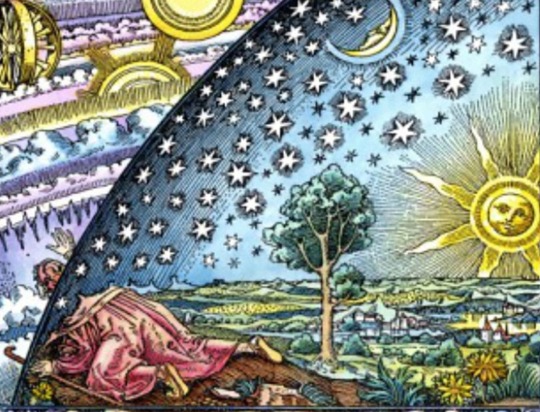
A Prophetic Dream
For many years, it has been my belief that our Universe is deterministic. Once its initial conditions were decided, I believed that no further choice was possible - the Universe would unfold according to the laws of its own operation in the one and only way it could unfold. Free will existed only at the global level, in the choice of its initial conditions. As individuals, we act as if we have free will because we only possess limited information about our local conditions; the underlying deterministic nature of the Universe is concealed by our imperfect limited knowledge. If we were omniscient, we would see that all actions in the Universe proceed inevitably from its initial conditions and its laws in an incomprehensibly vast predetermined pattern, right down to the smallest subatomic particle.
In quantum physics, this position is known as Superdeterminism. It is an interpretation of quantum physics that has existed alongside the Copenhagen Interpretation (e.g., "Schrödinger's cat) for the last century. Quantum physicists have known of the Superdeterminism interpretation all along, but they ignore it because in a deterministic Universe they - and all other scientists - would be out of a job (this is the "trivial solution" that falls out of Bell's Theorem.)
Anyway, that is what I believed until I had a highly significant dream tonight.
I have been working my way through the collected works of C.G. Jung, which I'm finding fascinating reading. Currently I'm reading his lectures on Synchronicity, the idea that meaningful coincidences can't simply be written off as statistical chance because they involve psychological meaning, which is outside the scope of statistics; statistics can only evaluate these uncanny phenomena by discounting their psychological aspects. This alters these phenomena and renders them (literally) meaning-less. So the uncanny cannot be explained away through statistics because synchronistic events do not obey the usual laws of causality. Sentient actors are at work, manipulating probability in ways that science cannot distinguish from ordinary coincidences lacking the crucial psychological component. This is borne out by repeated scientific studies showing that human actors can (slightly) alter random number generation in computers.
In my dream, I was prophesying the future. I had written my prophesies on two sets of clay tablets. I locked my predictions in an old suitcase and buried it in the earth until their time drew nigh. No sooner had I finished burying them than I was pursued by faceless shapes who wanted to know the future. I fled them and after some time managed to lose my pursuers. I doubled back to where I had buried the suitcase and dug up my prophesies.
I was astonished to discover that, while the first tablet was accurate in every detail, the second one was wrong. My actions to evade the shapes had altered the future such that the second half of the prophecies was no longer accurate. Then I awoke.
In the waking world, I was struck by the sense that this was no ordinary dream, and that I must write it down at once. As I did, the meaning of the dream came to me in a sudden gestalt.
The Universe does indeed obey deterministic laws, as Gottfried Leibniz believed with his notion of a Clockwork Universe. But it doesn't stop there. The Universe and its laws only apply to those realms where Time exists, for Time is an essential element in any deterministic system. The physical Universe is the realm that our bodies and brains inhabit, and they are subject to its laws. But our minds are eternal; they originate in realms that stand outside of Time, and they obey their own laws. Our minds interact with the Universe through the host bodies that we inhabit during one lifetime after another. While our minds inhabit our bodies they can act in the world, and as they do we alter the conditions of determinism. In other words: our physical bodies and brains lack free will, but our minds possess it. As sentient entities that exist outside of Time and the laws of the physical Universe, our minds can alter and redirect our future. It is analogous to us moving the hands on a clock to change the time it predicts. The clock is a deterministic mechanism, but we can change the time it displays.
In other words, the Clockwork Universe isn't wrong, it's just incomplete. Left to its own devices, the laws of the Universe will tick away in a clockwork, deterministic fashion. But it seldom gets to do so, because sentient actors from Outside the Universe - our minds - can and do reshape the future through their actions in the world. We are in the Universe without being entirely of the Universe. Our minds stand outside of Time and can change deterministic outcomes as if we were adjusting the hands of a clock. Once adjusted, the clock will continue to tick off the seconds as it always has done, but with the hands now in a new position and the future altered.
My dream revealed to me that we are not helpless actors in a deterministic Universe. We have agency and can alter our future. Thus the tablets in my dream: their prophesies were correct only for a brief window, until my own actions altered the future and invalidated my prophesies. Had I not acted to flee my pursuers, my prophesies would have come to pass once their hour rolled around at last.
#clairvoyance#prophecy#dreams#free will#superdeterminism#psychic#bell's theorem#quantum physics#uncanny#synchronicity#cg jung#clockwork universe#copenhagen interpretation#personal#me#carl jung
6 notes
·
View notes
Text
"Multiplicity is only apparent, in truth, there is only one mind."

Erwin Schrödinger was an Austrian physicist
Born 12 August 1887
Died 4 January 1961
#Erwin Schrödinger#Austrian physicist#Quantum mechanics#Schrödinger equation#Wave function#Quantum theory#Cat paradox#Nobel Prize in Physics#Quantum superposition#Wave-particle duality#Schrödinger's cat#Quantum entanglement#Quantum probability#Quantum states#Quantum mechanics interpretation#Particle physics#Quantum wavefunction#Copenhagen interpretation#Quantum philosophy#Quantum mechanics history#Quantum theory applications#Quantum theory development#Quantum theory principles#Schrödinger group#Quantum mechanics equations#Quantum mechanics principles#Quantum mechanics concepts#Quantum mechanics wave equation#Quantum mechanics wavefunction#Quantum mechanics discoveries
7 notes
·
View notes
Text
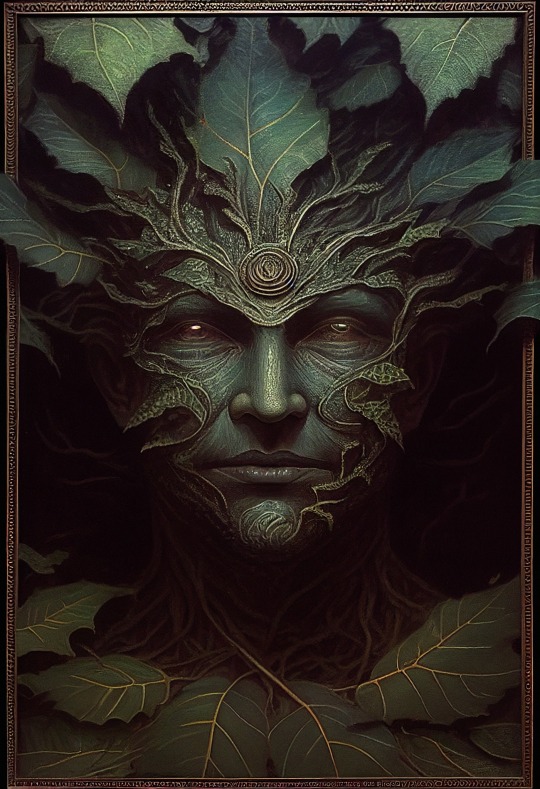
The Enigma of the Green Man
Symbol of life and nature:
The Celtic nature god Cernunnos from the Gundestrup Cauldron (1st Century BCE, now in the National Museum of Denmark in Copenhagen)
The Celtic nature god Cernunnos from the Gundestrup Cauldron (1st Century BCE, now in the National Museum of Denmark in Copenhagen)
The most common and perhaps obvious interpretation of the Green Man is that of a pagan nature spirit, a symbol of man’s reliance on and union with nature, a symbol of the underlying life-force, and of the renewed cycle of growth each spring. In this respect, it seems likely that he has evolved from older nature deities such as the Celtic Cernunnos and the Greek Pan and Dionysus.
Some have gone so far as to make the argument that the Green Man represents a male counterpart - or son or lover or guardian - to Gaia (or the Earth Mother, or Great Goddess), a figure which has appeared throughout history in almost all cultures. In the 16th Century Cathedral at St-Bertrand de Comminges in southern France, there is even an example of a representation of a winged Earth Mother apparently giving birth to a smiling Green Man.
Because by far the most common occurrences of the Green Man are stone and wood carvings in churches, chapels, abbeys and cathedrals in Europe (particularly in Britain and France), some have seen this as evidence of the vitality of pre-Christian traditions surviving alongside, and even within, the dominant Christian mainstream. Much has been made of the boldness with which the Green Man was exhibited in early Christian churches, often appearing over main doorways, and surprisingly often in close proximity to representations of the Christ figure.
Incorporating a Green Man into the design of a medieval church or cathedral may therefore be seen as a kind of small act of faith on the part of the carver that life and fresh crops will return to the soil each spring and that the harvest will be plentiful. Pre-Christian pagan traditions and superstitions, particularly those related to nature and trees, were still a significant influence in early medieval times, as exemplified by the planting of yew trees (a prominent pagan symbol) in churchyards, and the maintenance of ancient “sacred groves” of trees.
Tree worship goes back into the prehistory of many of the cultures that directly influenced the people of Western Europe, not least the Greco-Roman and the Celtic, which is no great surprise when one considers that much of the continent of Europe was covered with vast forests in antiquity. It is perhaps also understandable that there are concentrations of Green Men in the churches of regions where there were large stretches of relict forests in ancient times, such as in Devon and Somerset, Yorkshire and the Midlands in England. The human-like attributes of trees (trunk-body, branches-arms, twigs-fingers, sap-blood), as well as their strength, beauty and longevity, make them an obvious subject for ancient worship. The Green Man can be seen as a continuing symbol of such beliefs, in much the same way as the later May Day pageants of the Early Modern period, many of which were led by the related figure of Jack-in-the-Green.
Symbol of fertility:
Although the Green Man is most often associated with spring, May Day, etc, there are also several examples which exhibit a more autumnal cast to the figure. For example, some Green Men prominently incorporate pairs of acorns into their designs (there is a good example in King's College Chapel, Cambridge), a motif which clearly has no springtime associations. In the same way, hawthorn leaves frequently appear on English Green Men (such as the famous one at Sutton Benger), and they are often accompanied by autumn berries rather than spring flowers. The Green Man in the Chapelle de Bauffremont in Dijon (one of the few to retain its original paint coloration) shows quite clearly its leaves in their autumn colours.
This may have been simple artistic license. However, acorns, partly due to their shape, were also a common medieval fertility symbol, and hawthorn is another tree which was explicitly associated with sexuality, all of which perhaps suggests a stronger link with fertility, as well as with harvest-time.
Symbol of death and rebirth:
Green Man in the form of a skull on a gravestone in Shebbear, Devon, England (photo Simon Garbutt)
Green Man in the form of a skull on a gravestone in Shebbear, Devon, England
The disgorging Green Man, sprouting vegetation from his orifices, may also be seen as a memento mori, or a reminder of the death that await all men, as well as a Pagan representation of resurrection and rebirth, as new life naturally springs out of our human remains. The Greek and Roman god Dionysus/Bacchus, often suggested as an early precursor of the Green Man, was also associated with death and rebirth in his parallel guise as Okeanus.
Several of the ancient Celtic demigods, Bran the Blessed being one of the best known, become prophetic oracles once their heads had been cut off (another variant on the theme of death and resurrection) and, although these figures were not traditionally represented as decorated with leaves, there may be a link between them and the later stand-alone Green Man heads.
There are several examples of self-consciously skull-like Green Men, with vegetation sprouting from eye-sockets, although these are more likely to be found on tombstones than as decoration in churches (good examples can be seen at Shebbear and Black Torrington in Devon, England). Such images might be interpreted as either representing rebirth and resurrection (in that the new life is growing out of death), or they might represent death and corruption (with the leaves growing parasitically through the decaying body).
The Green Man by Talon Abraxas
40 notes
·
View notes
Note
This question might be in the realm of "stating the obvious" and I'm sorry if you've answered this before, but is there a reason why costumes in replica productions tend to be different in the details from one another? Does it have to do with which fabrics are available in Europe or in the US, or is it something else entirely?
It's not really an obvious answer, or rather: there are many parallelle answers. I can try to offer some of them. All of course exemplified with Christine costumes :D
One, even if the costume design is pretty detailed, many components is still up for interpretation. It means that one costume maker may see one thing, while another see another thing. I would say that both these Elissa tabs - 2000s West End to the left, 2006 US to the right - reflect on Maria Bjørnson's design (middle), even if they maybe don't look too alike when compared to eachother:

In the same vein, Maria Bjørnson supervised every new production worldwide and also every cast change in West End. At times she wanted to try out new details. For example, the Elissa gala skirt went from only tabs and apron in the initial design, to a plain green skirt with tabs and apron in the early West End production, to full-blown gala skirt with pleated hem around the world. This created some very different skirts in the early days.
Also, she was rarely satisfied with the Rooftop costumes, and constantly urged costume makers to try out new patterns, colours and effects. This means that new takes on the costumes was also initiated by the designer now and then. It also means the main costume has been made in white, blue, green, pink, purple and multi-coloured versions, and the cloak in pale mint, dark mint, sky blue and royal blue. All to try and convey a sense of moonlight in a dress!
Third, whereas the Wishing dress was almost always been made of the same stripy/floral blue silk from the UK (with a handful of exceptions in the US), the idea of a replica fabric for all costumes quickly collapsed. The early European and Japanese wedding bodices were made of the same silvery white ribbed fabric, but this was discontinued in the mid 1990s.
Same for the Rooftop costume, where the same beaded lace was used as the top fabric of the dress in both Stockholm, Hamburg and Toronto, but this too was discontinued in the 1990s. So it was up to Bjørnson, local costume makers and various supervisors to find the materials reflecting best on the design. It should also be mentioned that the materials preferred in the late 1980s and early 1990s often favoured colourful, highly patterned fabrics in the vein of chintz and Laura Ashley. The later 1990s and 2000s went for more subdued fabrics, while the current trend is thicker and colourful metallic and floral fabrics. So the current trends is also a factor.
Speaking of the blue silk for the Wishing dress, it seems an original idea was that the Christine alternate would wear a slightly different costume than the principal Christine. In West End it meant Claire Moore's main dress was made of the replica silk, but the petticoat was made of a blue taffeta with numerous horizontal navy velvet trims. On Broadway it meant Patti Cohenour's whole dress was made of a floral blue fabric.

Apart from these two and some 5 more Wishing dresses in the US, all versions of this replica costume has however been made of the stripy/floral blue silk. It remains probably the only current replica fabric, along with the Phantom's tailcoat. That black diamond patterned silk is from Savile Row in London, and identical all over the world. In other words, two absolute signature costumes!
A last thing that should be mentioned is that sometimes the BASE of the costume might be done in (for example) the UK, while the final fit and decorations is done locally. That can create quite different expressions even if the base and main fabric is the same. This was the case with Copenhagen, it is the case in the current South Korean production, and it was the case in the World Tour revival - to mention some. Add different wigs, accessories and/or underpinnings, and it can be hard to tell that the main costume is more or less the same:

(The South Korean base on the left and the West End base on the right is both made of the same fabric in the UK, but the decorations and the petticoat differs)
So yeah, not necessarily one obvious answer, but many overlapping practices that at times can affect the exact look of a specific costume. I hope that made sense!
53 notes
·
View notes
Note
Hi! I was just wondering who's your favorite phantom actor?
Can be from any Poto play, or movie, or anything really.
I'm really curious!
This and similar questions have been popping up so much for me in the last week lol
I like to be extremely specific so I will give you a few of my favourites
I have been meaning to re-examine my favourites for a while now
So my favourite overall, my number one, my blorbo, the phantom closest to my heart is always going to be Gerard Butler. Say what you want about his singing, but ain't no other phantom ever done Pleading Eyes (tm) like that man.
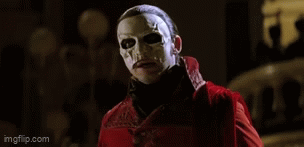

For stage Phantoms the one who has a hold on my mind that just will not let go is Tim Martin Gleason. I love a tall phantom. I love that in the title song he does not order Christine to sing for him, he asks her. He conveys, with his intonation, that he asks for the honour of having her sing for him. I love how expressive he is. This man made so many choices.
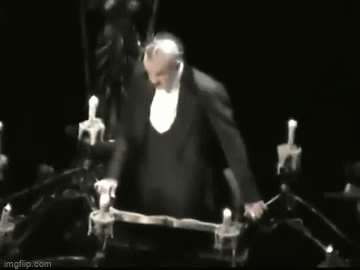
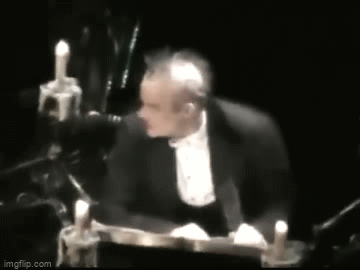

Vocally I think the best singer that has ever played the phantom is John Owen Jones. But I think my favourite phantom Vocally is Tomas Ambt Kofod, because he--more than ANY other Phantom I have heard, sounds like Erik. His voice is remarkable in its smoothness and delicacy, but also very powerful.
He's also so sensual and gentle. He loves to administer loving touches and caresses to his Christine.
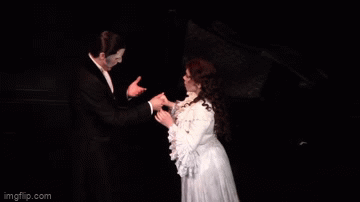
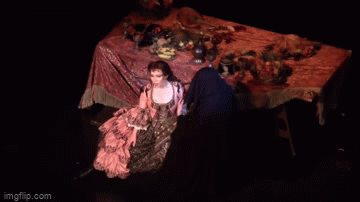
His final lair is also devastating
The Phantom actor I think I respect most is Ethan Freeman. This man has such a dedication to this character and to the book specifically. He refused to read Phantom by Susan Kay because he didn't want an apocryphal version of the character to influence his interpretation, which he specified modeled off of Leroux's Erik, adding touches pulled directly from the novel such as kissing (or almost kissing) the hem of Christine's robe during "Stranger Than You Dreamt It", as Erik kisses the hem of her dress in the book.
Seen here in the West End in 1995 with Jill Washington:
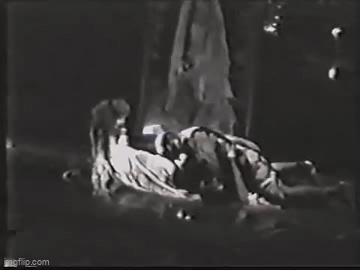
And here, in Essen, 11 years later with Anne Görner:
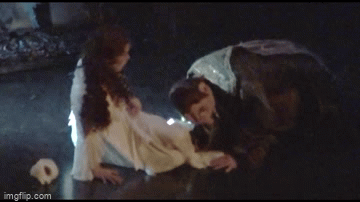
It seems that over time he evolved this moment to the point that he appears to abandon the thought before he brings it close to his lips--probably thinking he's not even worthy of touching her vestments.
He's got an almost faerie-goblin quality to his interpretation. Like he's just scuttled out of the Black Forest. He also leans into the idea of Erik-as-Magician
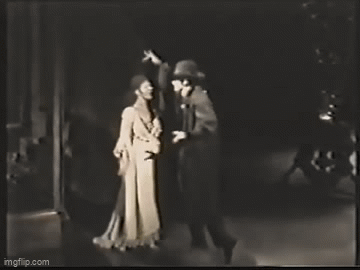
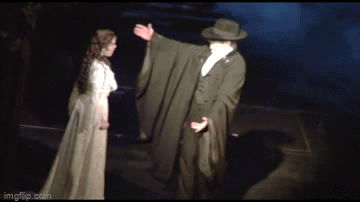
He's not afraid to be sensual either, though.
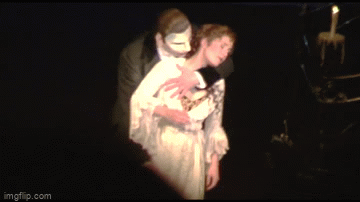
I think the most emotional phantom is Earl Carpenter. One of the first full boots I ever watched was Earl Carpenter with Rachel Barrel. His Music of the Night changed my brain chemistry forever. The gentleness! The vulnerability! The vacillation between confidence and fragility!!
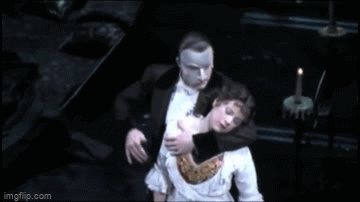
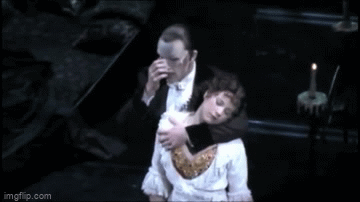
The way he would jostle Christine a little when he caught her, his face a picture of panicked concern!
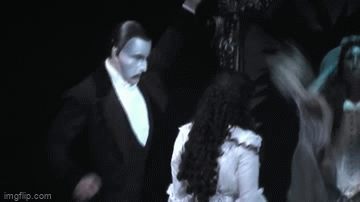
Though I think his interpretation of Erik as (for want of a better word) asexual is a little wacky (considering the text), it strangely works in favour of Erik's particular brand of sensuality, and it paired particularly well with Rachel's timid and apprehensive interpretation of Christine (which I generally dislike--here, though). And his singing has only improved with maturity. The raw emotion of his All I Ask of You (Rooftop Reprise) in his 2023 run is shattering. Absolutely shattering.
My favourite feral Phantom is without a doubt Scott Davies. If you ever want to see the most unhinged "Let these freaks be together" e/c show you've ever seen you have GOT to watch Scott Davies with Meredith Braun. Ethan Freeman's got the Goblin King energy and Anthony Crivello has the Sewer Gremlin vibe, but if you ever want a Phantom with a real primal streak, you can do no better than long-standing West End understudy Scott Davies:

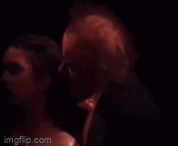

This guy tackled the role with a ferocity and an audacity that you don't generally find outside of Russian productions.
His Phantom hands? Oh Lordy!
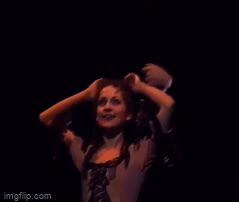
And the best part is that Meredith's Christine was picking up EVERYTHING he was laying down. Her Christine is just as mad, just as feral, just as unhinged. And especially paired with such a hearty goodfellow Raoul as Matthew Cammelle--Raoul would have done well to gtfo of there. He was NOT prepared to handle this lmao.
And then there's Ted Keegan. Who for me will always be the Phantom that got away. If I had just done a little more research before--just three months into my poto obsession--booking my tickets to see phantom before it closed on Broadway, I might have had the transcendent experience of seeing Ted Keegan live. As it was, I had no idea he was even still playing the phantom, and wound up with Ben Crawford instead.
And I would be remiss if I finished this list without naming Thomas James O'Leary. Like Ethan Freeman, O'Leary leans into Erik's ghostly persona, with a magician's touch. I think he took a lot of inspiration from Lon Chaney's Phantom (note the position of his hands here).
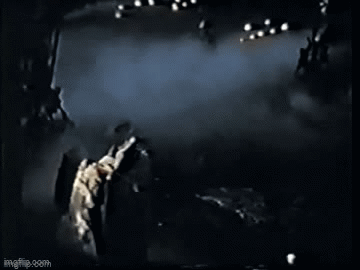

His "Sing for me~" is one of my all time favourite line readings and got a very embarrassing reaction out of me when I first heard it.
And then, as if that wasn't enough, there was the moan.
#asks#phantom of the opera#poto#poto musical#poto 2004#erik the phantom#gerard butler#tim martin gleason#scott davies#thomas james o'leary#ted keegan#ethan freeman#tomas ambt kofod#earl carpenter
62 notes
·
View notes
Text
More Caswen Headcanons because I have too many of these to fit in my mindbrain:
This one's long. A few years after their wedding, Ricky is selected as one of the Greene Foundation's Global Ambassadors for the Universal Language Project, or in other words, he gets to travel the world a bit to help encourage musical education globally. EJ doesn't have to come with him...but he does want to, so he quits his job (cordially, they understand it's not like he hates it there) and learns as much as he can about the variants of sign language in the areas they'll be traveling to so he can interpret for Ricky. Ricky also attempts to learn some, but really only succeeds in remembering 'Sorry' 'Please' and 'I love you'.
Building on that last one, EJ's favourite location they live for a period is Sweden, while Ricky's favourite is a tie between Wales and Italy. As a result of that, once they finish Ricky's time as an Ambassador, they settle in Copenhagen and EJ lands a job at the University of Copenhagen while he works on a second Masters degree there.
They adopt a Bernese Mountain Dog name Lykke and a Husky named Kota (because I couldn't resist).
One of EJ's nicknames for Ricky is 'Mr. Whiskers' for twofold reasons, because whenever EJ plays with Ricky's hair he leans into it like a cat, and also because of EJ enjoying the time Ricky attempted to grow facial hair.
They both cry at emotional movie moments. Frequently.
Ricky: Golden Retriever Boyfriend, EJ: Black Cat Mask hiding another Golden Retriever Boyfriend
EJ watches anime because he's fascinated by the art form, Ricky watches with him because he enjoys the stories, the colors, and any excuse to cuddle with his husband.
EJ drinks coffee in the morning, Ricky does not, but since he's up earlier anyway, EJ makes it a habit to visit one of a few local cafés every couple days and pick up a different pastry each time for Ricky's sweet tooth.
Speaking of which, Ricky loves couple costumes for Halloween, which EJ's willing to go along with out of love.
Ricky always knows when EJ is getting too stressed about work and will come up (much like a cat or dog) and demand attention until EJ relents and takes a break.
EJ is very much a New Years person, and thus Ricky has a bunch of contacts lined up for restaurant/event dates around that time.
Ricky found out how much he loves traveling while they were moving around for the Ambassador thing, so EJ always arranges a 2+ week vacation in the summer to at least one location they haven't been yet. Sometimes with at least one of the other Wildcats joining them.

#ej caswell#ricky bowen#caswen#hsmtmts#matt cornett#joshua bassett#ship headcanons#i love them to an unhealthy degree
39 notes
·
View notes
Text
How to Use Quantum Computing as a Tool for Philosophy of Science
Recently, I attended the MCQST 2023 Conference on which Lídia del Rio presented the research with her collaborators about quantum thought experiments in a quantum computer. They wrote a whole package to do this and describe the ideas in detail in [1]. It's definitely worth checking out the paper and the package - to make you curious let us look at an illustrative example [1, p.4-10].
Example Setting

Let us consider the following setting (as depicted in the image above): Alice has some two-level quantum system R (e.g. a qubit) in the state written in blue. Thus, the probability of obtaining a=0 in a measurement is 1/3 while the result a=1 will be obtained with a probability 2/3. Depending on the outcome, Bob receives the a system in state |0> (if Alice's result was a=0) or in state |+> ~ |0>+|1> (if Alice's result was a=1). In turn, Bob measures his system in the computational basis and can receive the outcome b=0 or b=1. What conclusions can Bob draw about Alice's measurement outcomes based on his? It is assumed that Bob knows the rules upon which Alice sends him the different systems. Thus, if his outcome is b=0 he cannot make any retrodiction since the outcome b=0 could stem from both possible states |0> and |+>. However, if he measures b=1 he knows that his state must have been in |+> and thus he can retrodict that Alice's outcome must have been a=1. Therefore, in one of both cases Bob can draw a deterministic conclusion about Alice's outcome.
So far so good, at this point I'd like to mention that even though this setup seems to be motivated by the Frauchiger-Renner Thought Experiment, we will not talk about apparent paradoxes or fundamental questions in foundations of quantum mechanics themselves. Instead the setting is supposed to be easy to grasp and can therefore neatly serve the purpose to illustrate how a thought experiment can be formalized in terms of quantum circuits. Hence, we will discuss a tool which can be used for quantum thought experiments in general by using a simple example.
Alice's and Bob's Brains in a Quantum Circuit

Next, we will translate this specific setting as a quantum circuit - by going through the above illustration of the resulting circuit. The first qubit is initialized in the state of Alice's system R. Even though this seems to be the only true quantum system at hand, we will act as if there was an external observer who looks at both Alice and Bob and their respective systems. Imagine you are in the position of this external observer and set the Heisenberg cut at this point: You are classical while both Alice and Bob are quantum (as it is done in Neo-Copenhagen interpretations). Then, one also has to model the "brains"/"memory" of both Alice and Bob. We start with Alice first: we assign a wire of the circuit to Alice's reasoning which basically means that somehow the possible measurement results are stored in this respective qubit. The wire representing her memory is initialized in state |0> and is connected to her system R via a CNOT gate. This means that if the system R was in state |0>, the qubit representing Alices would stay in |0>. However, if R was in |1>, Alice's state of memory would be in |1> as well. This way, one can model different measurement outcomes and also Alice's memory in a unitary manner without explicitly including measurements in the circuits yet. This is necessary since from our external perspective everything about Bob and Alice is considered to be quantum, i.e. must be modelled unitarily. Now, we can look at the third wire: It is again initialized in state |0> and remains in this state if Alice's memory is in state |0>. However, the controlled Hadamard will act on the third wire if Alice's memory is in state |1>, hence it would be turned into state |+>. Thus the controlled Hadamard models the system S which Bob receives - conditioned on Alice's measurement outcome of R. Finally, the last wire is again initialized in |0> and is supposed to model Bob's memory. Exactly as Alice's memory, also the relation between Bob's memory and his system S is modeled via a CNOT gate.
As a result we now have a quantum circuit which represents the setup from above from an external perspective. I think already at this point one can see the beauty of this approach - while one needs quite a lot of sentences to explain the simple setup, it can very easily be grasped by the neat quantum circuit. What is left to do now is to model Bob's reasoning regarding his retrodiction on Alice's outcome. We found that Bob can draw a deterministic conclusion about Alice's measurement outcome if his outcome is b=1, in the other case he cannot draw such a conclusion. How can this be mapped into a quantum circuit?
Modelling Bob's reasoning
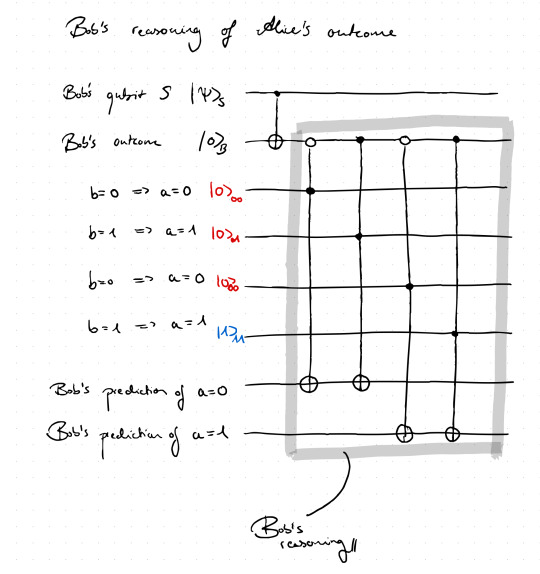
In the above circuit we added a couple of additional wires. One set represents the four possible logical inferences in this case, and the last two wires will show what Bob's prediction will be based on the initialized inferences. Let's go through this step by step:
There are four possible inferences on the measurement outcomes a and b, but only one of them is assumed to hold, namely (b = 1 -> a=1), which is why only the wire corresponding to this inference is initialized in state |1>. The other three inferences, which are assumed not to hold, are initialized in |0> and since there are control nodes from the nonlocal Toffoli-type on those wires, they will not really contribute as long as one does not change the initialization. Those Toffoli-type gates have two control nodes each as well as a NOT at the lower end. One control node is placed on Bob's memory qubit, acting dependently on the outcome b and represents the antecedent of each possible inference. If the inference of a wire assumes b=1 the corresponding Toffoli node on Bob's memory will be black, while it will be white for b=0. The second control node of each Toffoli gate is black in order to be activated according to which inference is initialized with state |1>. The consequent of those inferences is modeled by the lowest two wires. The NOT of each Toffoli is placed on the corresponding wires representing the consequent. Looking at the Toffoli for the inference b=1 -> a=1, one can see that if Bob's memory is in |1> and simultaneously the wire of the corresponding inference is initialized as |1> as well, the NOT on the lowest wire will turn the respective state to |1> (the prediction wires are initialized in |0>). Thus, Bob's prediction can be read off by the states of the prediction wires. Finally, one can also run this circuit and check its consistency - how?
Consistency Checks

In the above image we have put together all we got so far: Alice's actions from before, as well as bob's actions and his reasoning as discussed right above. The consistency of such a model can be checked by measuring the prediction wires as well as Alice's memory qubit. In this case, the only deterministic inference will show itself if Bob's prediction wire for a=1 will be |1> and this will coincide with Alice's memory being in |1>. For the other case, no inference can be done. This way one can check the consistency of the model and if the results show paradoxical outcomes one knows that something went wrong, that something in the logical reasoning / adopted interpretation of quantum theory is getting problematic. Having everything formalized as a quantum circuit will make the analysis of the issues easier.
Final Remarks
It appears to me that Quantum Circuits are not used here because one expects some computational advantage by running them on a Quantum Computer - instead they are used to neatly formalize subsystems and possible inferences of thought experiments. This way, thought experiments can be made more clear and transparent as well as it is easier to see the problem if the outcomes are not consistent. Therefore, their work shows that quantum circuits have a much broader field of application - it is not only about striving for some kind of quantum advantage for specific decision problems, instead they can also be used to formalize concepts in foundations of quantum mechanics; and this is something I have never thought about before, which is why I am so fascinated by the idea.
---
References:
[1] Nurgalieva, Mathis, del Rio, Renner - Thought experiments in a quantum computer. arXiv:2209.06236
#physics#mysteriousquantumphysics#quantum physics#studyblr#physicsblr#science#education#quantum#philosophy of science#philosophy#quantum computing
102 notes
·
View notes